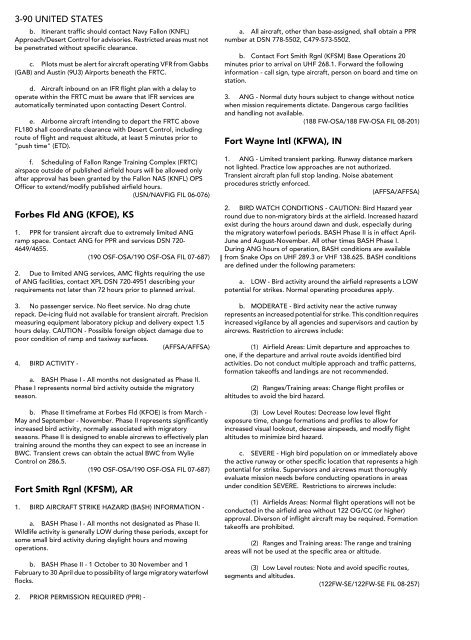NORTH AND SOUTH AMERICA - CNATRA - The US Navy
NORTH AND SOUTH AMERICA - CNATRA - The US Navy
NORTH AND SOUTH AMERICA - CNATRA - The US Navy
Create successful ePaper yourself
Turn your PDF publications into a flip-book with our unique Google optimized e-Paper software.
3-90 UNITED STATES<br />
b. Itinerant traffic should contact <strong>Navy</strong> Fallon (KNFL)<br />
Approach/Desert Control for advisories. Restricted areas must not<br />
be penetrated without specific clearance.<br />
c. Pilots must be alert for aircraft operating VFR from Gabbs<br />
(GAB) and Austin (9U3) Airports beneath the FRTC.<br />
d. Aircraft inbound on an IFR flight plan with a delay to<br />
operate within the FRTC must be aware that IFR services are<br />
automatically terminated upon contacting Desert Control.<br />
e. Airborne aircraft intending to depart the FRTC above<br />
FL180 shall coordinate clearance with Desert Control, including<br />
route of flight and request altitude, at least 5 minutes prior to<br />
"push time" (ETD).<br />
f. Scheduling of Fallon Range Training Complex (FRTC)<br />
airspace outside of published airfield hours will be allowed only<br />
after approval has been granted by the Fallon NAS (KNFL) OPS<br />
Officer to extend/modify published airfield hours.<br />
(<strong>US</strong>N/NAVFIG FIL 06-076)<br />
Forbes Fld ANG (KFOE), KS<br />
1. PPR for transient aircraft due to extremely limited ANG<br />
ramp space. Contact ANG for PPR and services DSN 720-<br />
4649/4655.<br />
(190 OSF-OSA/190 OSF-OSA FIL 07-687)<br />
2. Due to limited ANG services, AMC flights requiring the use<br />
of ANG facilities, contact XPL DSN 720-4951 describing your<br />
requirements not later than 72 hours prior to planned arrival.<br />
3. No passenger service. No fleet service. No drag chute<br />
repack. De-icing fluid not available for transient aircraft. Precision<br />
measuring equipment laboratory pickup and delivery expect 1.5<br />
hours delay. CAUTION - Possible foreign object damage due to<br />
poor condition of ramp and taxiway surfaces.<br />
(AFFSA/AFFSA)<br />
4. BIRD ACTIVITY -<br />
a. BASH Phase I - All months not designated as Phase II.<br />
Phase I represents normal bird activity outside the migratory<br />
season.<br />
b. Phase II timeframe at Forbes Fld (KFOE) is from March -<br />
May and September - November. Phase II represents significantly<br />
increased bird activity, normally associated with migratory<br />
seasons. Phase II is designed to enable aircrews to effectively plan<br />
training around the months they can expect to see an increase in<br />
BWC. Transient crews can obtain the actual BWC from Wylie<br />
Control on 286.5.<br />
(190 OSF-OSA/190 OSF-OSA FIL 07-687)<br />
Fort Smith Rgnl (KFSM), AR<br />
1. BIRD AIRCRAFT STRIKE HAZARD (BASH) INFORMATION -<br />
a. BASH Phase I - All months not designated as Phase II.<br />
Wildlife activity is generally LOW during these periods, except for<br />
some small bird activity during daylight hours and mowing<br />
operations.<br />
b. BASH Phase II - 1 October to 30 November and 1<br />
February to 30 April due to possibility of large migratory waterfowl<br />
flocks.<br />
2. PRIOR PERMISSION REQUIRED (PPR) -<br />
a. All aircraft, other than base-assigned, shall obtain a PPR<br />
number at DSN 778-5502, C479-573-5502.<br />
b. Contact Fort Smith Rgnl (KFSM) Base Operations 20<br />
minutes prior to arrival on UHF 268.1. Forward the following<br />
information - call sign, type aircraft, person on board and time on<br />
station.<br />
3. ANG - Normal duty hours subject to change without notice<br />
when mission requirements dictate. Dangerous cargo facilities<br />
and handling not available.<br />
(188 FW-OSA/188 FW-OSA FIL 08-201)<br />
Fort Wayne Intl (KFWA), IN<br />
1. ANG - Limited transient parking. Runway distance markers<br />
not lighted. Practice low approaches are not authorized.<br />
Transient aircraft plan full stop landing. Noise abatement<br />
procedures strictly enforced.<br />
(AFFSA/AFFSA)<br />
2. BIRD WATCH CONDITIONS - CAUTION: Bird Hazard year<br />
round due to non-migratory birds at the airfield. Increased hazard<br />
exist during the hours around dawn and dusk, especially during<br />
the migratory waterfowl periods. BASH Phase II is in effect April-<br />
June and August-November. All other times BASH Phase I.<br />
During ANG hours of operation, BASH conditions are available<br />
from Snake Ops on UHF 289.3 or VHF 138.625. BASH conditions<br />
are defined under the following parameters:<br />
a. LOW - Bird activity around the airfield represents a LOW<br />
potential for strikes. Normal operating procedures apply.<br />
b. MODERATE - Bird activity near the active runway<br />
represents an increased potential for strike. This condition requires<br />
increased vigilance by all agencies and supervisors and caution by<br />
aircrews. Restriction to aircrews include:<br />
(1) Airfield Areas: Limit departure and approaches to<br />
one, if the departure and arrival route avoids identified bird<br />
activities. Do not conduct multiple approach and traffic patterns,<br />
formation takeoffs and landings are not recommended.<br />
(2) Ranges/Training areas: Change flight profiles or<br />
altitudes to avoid the bird hazard.<br />
(3) Low Level Routes: Decrease low level flight<br />
exposure time, change formations and profiles to allow for<br />
increased visual lookout, decrease airspeeds, and modify flight<br />
altitudes to minimize bird hazard.<br />
c. SEVERE - High bird population on or immediately above<br />
the active runway or other specific location that represents a high<br />
potential for strike. Supervisors and aircrews must thoroughly<br />
evaluate mission needs before conducting operations in areas<br />
under condition SEVERE. Restrictions to aircrews include:<br />
(1) Airfields Areas: Normal flight operations will not be<br />
conducted in the airfield area without 122 OG/CC (or higher)<br />
approval. Diverson of inflight aircraft may be required. Formation<br />
takeoffs are prohibited.<br />
(2) Ranges and Training areas: <strong>The</strong> range and training<br />
areas will not be used at the specific area or altitude.<br />
(3) Low Level routes: Note and avoid specific routes,<br />
segments and altitudes.<br />
(122FW-SE/122FW-SE FIL 08-257)

















